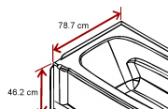
The inner dimensions of your bathtub are an important consideration, especially if you have tall people in your family. They also dictate how easily you can ‘soak’.
When choosing a bathtub, it makes good sense to choose one that will comfortably fit the largest person who intends to use it. This doesn’t necessarily mean that you need to get a bathtub that’s as long as that person is tall though – if space is limited, you can compensate for having a short tub by getting one with a bit of depth.
The length and width of the tub you choose is obviously affected by how much space in your bathroom too – and you will need clearance around it to get in and out safely. Depending on how much room you have to play with, your choice of tub may be limited, especially if you need to leave room in your bathroom for other amenities like a toilet or a separate shower stall.

Bath width and length
In Australia, standard baths measure about 1.5m x 0.75m, but there are so many variations on the ‘standard’ bath that it’s unlikely you’ll have any difficulty in finding something else should you need something with different dimensions. Anybody over about 180cm (6 feet) tall is likely to find this standard size pretty uncomfortable.
Bathtubs are often referred to in terms of their length in millimetres (e.g. 1500, 1700) – but as you can see in the diagram, this length also includes the rim of the bathtub at each end. For that reason, it’s generally not practical to assume that a 1600mm bathtub will be comfortable if you’re 180cm (1800mm) tall.
The easiest way to determine how long and wide your new bathtub should be is simply to go and sit in a few. There are no hard and fast rules about different bath sizes for different sized people, and different shapes will appeal to different people. Longer tubs will often be wider than shorter ones, but some tubs are also built wider to accommodate two people.
As a rule of thumb, an 1800mm tub is likely to be more comfortable for people around 6 feet tall – although that really does depend on the tub as much as it does on your own expectations (and willingness to let your knees get a bit cold)…
Bigger tubs = more energy
Keep in mind that a longer and wider tub will require extra water to fill it every time it’s used. A warm bath normally requires about 65% hot water, so you’ll need to make sure that your hot water system is capable of supplying that volume of water comfortably. If you have a continuous flow hot water system this won’t make a difference, but if you have a storage tank based hot water system it’s a good idea to check its capacity before you go shopping.
Another important consideration when you’re thinking about the width of the bath is where the taps will go. If you’re planning on installing a wide bath, you need to make sure that the taps are easily accessible to people both inside and outside of the bath.
Depth of your bath
The depth of the tub will also affect how it suits different people, and can make an otherwise fairly short tub comfortable for taller people. There are also deeper tubs known as soaking tubs (or soak tubs) which are designed in a way that allows you to immerse your body almost completely.
Depth is a particularly important consideration if you are planning to install the tub flush with the ground, as you will need to have enough space beneath it to accommodate not only the bath itself but also the necessary plumbing and insulation, if you are using it. The depth of the tub is likely to be a critical issue for elderly and physically disabled people too, and in some cases a specially designed tub may be a better solution than a standard-sized tub.
Replacing an existing tub
If you’re upsizing your bathtub, be sure to consider whether or not the waste in the new tub (i.e. the drain hole) is in the same position as it was in the original tub. If you’re replacing a tub that had a plughole at one end with a new one that has a centre waste, for example, there’s a chance it’ll need extra piping underneath to reach the original drain outlet – which may mean the tub has to be set higher (particularly if your house sits on a concrete slab), and may also mean you’re up for more in terms of plumbing costs.




